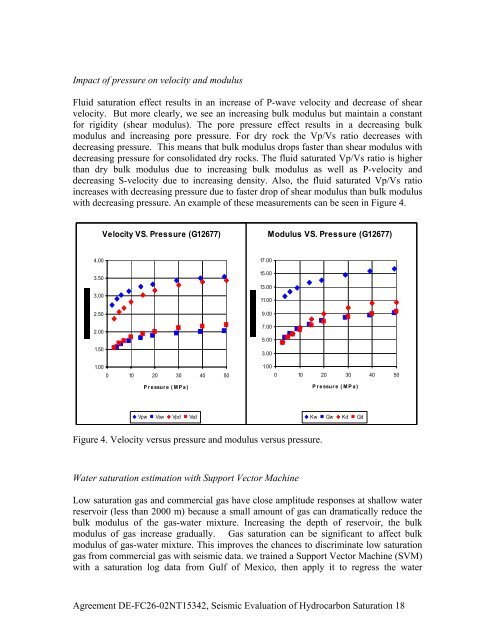Agreement DE-FC26-02NT15342, Seismic Evaluation of ...
Agreement DE-FC26-02NT15342, Seismic Evaluation of ...
Agreement DE-FC26-02NT15342, Seismic Evaluation of ...
Create successful ePaper yourself
Turn your PDF publications into a flip-book with our unique Google optimized e-Paper software.
Impact <strong>of</strong> pressure on velocity and modulus<br />
Fluid saturation effect results in an increase <strong>of</strong> P-wave velocity and decrease <strong>of</strong> shear<br />
velocity. But more clearly, we see an increasing bulk modulus but maintain a constant<br />
for rigidity (shear modulus). The pore pressure effect results in a decreasing bulk<br />
modulus and increasing pore pressure. For dry rock the Vp/Vs ratio decreases with<br />
decreasing pressure. This means that bulk modulus drops faster than shear modulus with<br />
decreasing pressure for consolidated dry rocks. The fluid saturated Vp/Vs ratio is higher<br />
than dry bulk modulus due to increasing bulk modulus as well as P-velocity and<br />
decreasing S-velocity due to increasing density. Also, the fluid saturated Vp/Vs ratio<br />
increases with decreasing pressure due to faster drop <strong>of</strong> shear modulus than bulk modulus<br />
with decreasing pressure. An example <strong>of</strong> these measurements can be seen in Figure 4.<br />
Velocity VS. Pressure (G12677)<br />
Modulus VS. Pressure (G12677)<br />
4.00<br />
3.50<br />
3.00<br />
2.50<br />
2.00<br />
1.50<br />
1.00<br />
0 10 20 30 40 50<br />
Pressure (MPa)<br />
17.00<br />
15.00<br />
13.00<br />
11.00<br />
9.00<br />
7.00<br />
5.00<br />
3.00<br />
1.00<br />
0 10 20 30 40 50<br />
Pressure (MPa)<br />
Vpw Vsw Vpd Vsd<br />
Kw Gw Kd Gd<br />
Figure 4. Velocity versus pressure and modulus versus pressure.<br />
Water saturation estimation with Support Vector Machine<br />
Low saturation gas and commercial gas have close amplitude responses at shallow water<br />
reservoir (less than 2000 m) because a small amount <strong>of</strong> gas can dramatically reduce the<br />
bulk modulus <strong>of</strong> the gas-water mixture. Increasing the depth <strong>of</strong> reservoir, the bulk<br />
modulus <strong>of</strong> gas increase gradually. Gas saturation can be significant to affect bulk<br />
modulus <strong>of</strong> gas-water mixture. This improves the chances to discriminate low saturation<br />
gas from commercial gas with seismic data. we trained a Support Vector Machine (SVM)<br />
with a saturation log data from Gulf <strong>of</strong> Mexico, then apply it to regress the water<br />
<strong>Agreement</strong> <strong>DE</strong>-<strong>FC26</strong>-<strong>02NT15342</strong>, <strong>Seismic</strong> <strong>Evaluation</strong> <strong>of</strong> Hydrocarbon Saturation 18
















